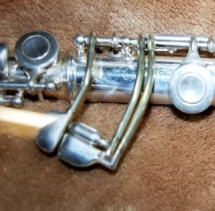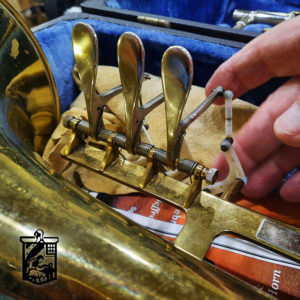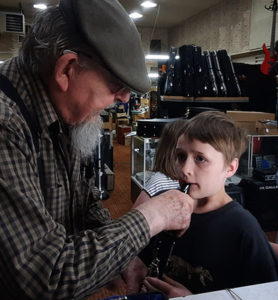I was re-reading a chapter in Alex Bigney’s book “Talking to Tesla” the Quickening and it reminded me of myself and my work solving problems with Musical Instruments. I do not have Tesla to talk to, however, I do from my years of experience to draw on, to contemplate and evaluate a solution to a problem or a modification to an instrument to help a musician that is fighting the way an instrument is performing for them.
A plan often comes to my mind’s eye the moment I see the instrument and have the player demonstrate their concerns. I then present the plan to the client for approval, then work the plan to solve the musician’s problem. Most needs arise as perhaps those that have been good when younger and when the musician ages. We see many physical problems occur that the musician feels an inability to perform as they did when younger or after a medical trauma.
I have had the opportunity to advise those who come to me for advice, or to simply modify their instrument to function as it did when younger or before a trauma, be it physical or mental. I have been repairing, restoring and modifying instruments for 65 years and I feel that I have passed the 10,000-hour rule stated by Malcolm Gladwell in his book “Outliers.” I now have been documenting my work with the new tools that are available to me and have many photos of different modifications that have solved problems for many musicians.
St. Paul Chamber Orchestra principal flutist, Julia Bogorad, while playing with the Teton Festival Orchestra in Jackson, Wyoming came into my Shop in 1983. She asked if I could help with the placement of a hand crutch on her Flute because she had such small hands and it was difficult to reach the keys on her left-hand easily. We repositioned the crutch on the bottom of her Muramatsu Silver Flute as she directed. Several years later Julia contacted me by phone and ask if I would be able to make some modifications to the keys on her Flute. The Festival orchestra did not rehearse on Mondays and She could come over when we opened at 10 AM. We discussed her needs and came up with a plan to extend the B, A/G, and G# keys.
Since we needed solid silver of a size that was thicker than my stock I went down to the Pawn Shop and pick out some sterling silver spoons that had enough thickness. I then proceeded to form the silver into the key extensions according to the plans Julia had approved. At 10 PM that evening Julia was pleased with the modifications and returned to Jackson. I later went to Jackson to hear the debut of a new composition of a Flute concerto featuring antiphonal Flutes. The Echoing Flute in the back of the orchestra, the effect was beautiful.
Later I found out that She took her modified Flute to Powell Flute company and wanted them to make the same modifications that I had made on her Muramatsu Flute, they just added half dines to the keys and said that’s all that they would do. For prestige, she can say she plays a Powell Flute, however, when playing a solo she uses her Muramatsu Flute. Julia Bogorad-Kogan is now re-married and is still playing professionally in Minnesota to Boston areas.
A few years later a Mother from Driggs, Idaho came into the shop and asked if I could help her daughter play her Flute, however, the daughter had inherited her Father’s hand with the very short little finger on her right hand and asked if I could modify her Flute to accommodate her hand. I presented a plan to extend the keys on the foot joint to fit the hand of her daughter. Fifteen years later the now married young lady brought her Flute in for regulation. I asked her if I could photograph her Flute so I would have documentation of the modification that I had performed earlier, she was agreeable. The player now lives in Idaho Falls and is still playing her Flute.
The photo on the left is of the modifications I performed on the Flute. The photo on the right is an example of the original position of the keys. I am pleased that the modification has worked so well for this young Lady. Below is a picture of a normal flute.




